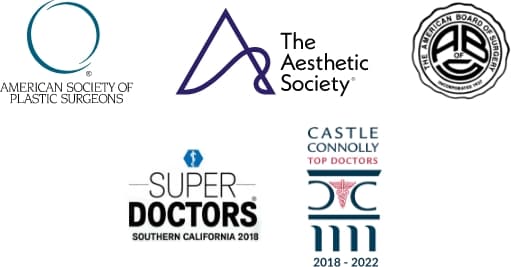Dr. Richardson and Dr. Memsic are two of the top breast surgeons in Los Angeles, using innovative techniques to create excellent clinical and aesthetic outcomes.
Schedule a Visit
Bedford Breast Center
436 N Bedford Dr, Ste 308
Beverly Hills, CA 90210
Phone: (310) 278-8590
Monday – Friday: 9 a.m.– 5 p.m.
Mastitis
When you have a newborn, changes in your breasts are the last thing you want to worry about. However, pain, redness, swelling, and warmth accompanied by difficulties with breastfeeding can signal a common condition called mastitis.
What Is Mastitis?
Mastitis is a medical condition that occurs when the breast tissue becomes infected or inflamed. In breastfeeding mothers (“lactational mastitis”), it is typically caused by inadequate milk drainage from the breasts. This blockage (stasis) of the milk glands, can cause the milk to stagnate and become a breeding ground for bacteria.

Symptoms commonly include the following:
- Localized breast pain accompanied by tenderness and warmth
- Redness and swelling
- A lump in the breast caused by a blocked milk duct
- Fever and chills
- Nipple discharge (in non-breastfeeding women)




What Causes Mastitis?
Multiple factors can lead to infection and inflammation of the breast tissue, such as:
Engorgement and Inadequate Milk Drainage
Breastfeeding challenges or infrequent feedings can contribute to blocked milk ducts and bacterial growth.
Nipple Trauma
During breastfeeding, bacteria from the baby’s mouth or the surrounding environment can enter the milk ducts through tiny openings in the nipple (particularly in areas where the skin is broken).
Hyperlactation (Oversupply)
Excessive breast milk increases pressure in the breast tissue which can lead to narrowing of the milk ducts, drainage issues, and engorgement. These issues can prevent adequate milk flow and increase the risk of developing an infection.
Weakened Immune System
Chronic fatigue, stress, or illness can make the body more susceptible to infection.
If you suspect you have mastitis, especially when accompanied by fever and flu-like symptoms, seek urgent medical attention.
“Extremely knowledgeable, responsive group who genuinely care. I recently experienced back-to-back cases of mastitis and needed a mammogram and ultrasound. My current health group could not schedule me until 3 months out, which was unacceptable with repetitive cases of mastitis. My lactation consultant recommended the Bedford Breast Center, and they were able to book me within the week. During my visit, they found they needed to collect a sample and we’re able to fit me in while I was there, which was both convenient and reassuring to address this all in the immediate. As soon as the results were in, I was contacted by [the PA] to discuss immediate care and schedule follow-ups. Everyone there was wonderful, and I really appreciated [her] sense of care, approachability, and professionalism.”
Hayley S. – Yelp
How Is Mastitis Treated?
Treatment for mastitis typically involves a combination of approaches. You will likely be prescribed antibiotics to clear the infection and be given over-the-counter pain relievers like ibuprofen or acetaminophen to alleviate discomfort and reduce the fever. Always complete the entire course of antibiotics, even if your symptoms improve.
Women can use cold compresses and gentle self-massage to encourage milk flow and reduce pain and swelling. Adequate rest and hydration will also support your immune system.
In most cases, you will need to keep breastfeeding or pumping to avoid further milk stasis. Ensuring proper milk drainage can help clear the infection and resolve the condition faster.
How Can Mastitis Be Prevented?
Although some causes of mastitis are beyond your control, you can take some proactive steps to reduce your risk:
- Ensure proper latch and positioning when breastfeeding to prevent nipple trauma and engorgement.
- Practice good breastfeeding hygiene to minimize infection risks.
- Prioritize self-care to promote a healthy immune system.
- Seeing a lactation consultant or taking a breastfeeding class may be helpful to learn proper breastfeeding and pumping technique.
In addition, soy lecithin supplements can help to thin secretions and improve milk flow. Probiotics with Lactobacillus can also prevent harmful bacteria growth by balancing natural flora.
Mastitis FAQ
Does mastitis pose a risk to infants?
In most cases, there is no direct threat to the infant, and you will be encouraged to continue breastfeeding.
Can mastitis affect breastfeeding and milk supply?
Mastitis can cause temporary supply issues in the affected breast(s) and may make breastfeeding uncomfortable.
Can mastitis be mistaken for a symptom of breast cancer, or vice versa?
Inflammatory breast cancer is a rare but aggressive form of breast cancer that can mimic the symptoms of mastitis (redness, swelling, warmth), which can lead to confusion in diagnosis. If symptoms don’t improve with standard treatments or if there are other concerning features, it’s important to rule out the possibility of breast cancer.
View Featured Before & After Photos
If you suspect you have mastitis or are experiencing other breastfeeding difficulties, please contact our team of breast specialists by calling (310) 278-8590 or using our online form.
